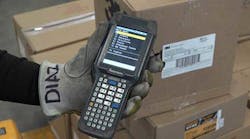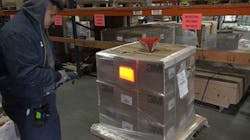Multi-Location WMS Implementations Were an Easy Lift for Hercules
Hercules Industries started 65 years ago in Denver as a wholesale distributor of a complete line of HVAC products and supplies. They’ve evolved over the years to also become a steel fabricator that now manufactures its own ductwork for projects ranging from skyscrapers to single-family homes. Today, Hercules has four manufacturing facilities and 20 sales and distribution centers in Arizona, Colorado, New Mexico, Texas, Utah, and Wyoming.
Hercules stocks approximately 11,500 SKUs for a customer base that includes everyone from large commercial wholesalers all the way down to small residential mechanical contractors. Each branch location also has a retail store where the company sells directly to homeowners. With such a diverse product base and growing customer portfolio, Hercules’ aging enterprise resource planning (ERP) system was being pushed to its limits.
To modernize its distribution operations, Hercules partnered with PathGuide Technologies to pursue an extensive Latitude Warehouse Management System (WMS) implementation. The project started at Hercules’ main distribution center the first year and then ramped up to its other 19 locations over the next two years. One of the biggest hurdles the company faced was integrating with its legacy ERP system, which Hercules chief financial officer Dan Luzietti concisely describes as “adequate.”
Challenges: Some Familiar, Some Unique
What kind of challenges did Hercules face? Many of the same challenges as other companies who run distribution operations via printed paper that is produced by the ERP system. Hercules attempted to rectify their limitations by building the graphical display of a picking ticket via a browser on tablets for pickers. However, such tools provide an interim stop-gap solution at best and do not provide the full suite of inventory and warehouse management tools that a good WMS provides and that successful distributors need to stay ahead of their competitors.
In addition, Luzietti was quick to note some decisions that were made roughly five years before Hercules’ implementation, which resulted in making its WMS project a bit out of the ordinary. “We changed the programming in our ERP to complement our workflow, rather than take the program and modify our workflow to best complement it,” Luzietti says. “In many instances, we had painted ourselves into a corner with some custom programming within our systems that we first had to undo before we could implement Latitude.”
Fortunately for Hercules, PathGuide was more than up for the task.
Change Management? “It’s About Time!”
Instead of viewing this as an insurmountable obstacle, Hercules instead saw an opportunity to bring a change management perspective to the task. According to Luzietti, the team’s approach was to “organize our warehouse layout so that we can think in terms of pick-pack efficiency.” The result? A shift in thinking from “we always put this group of items here and that group of items over there… to a new potential.”
Because the company’s mission is to nurture and maintain the culture of a family-owned business where employees grow financially, intellectually, emotionally, and spiritually, the average employee at Hercules has been with the company for approximately 10 years. Change can often be difficult or even downright unwelcome at many established companies. So how did a workforce that’s been with Hercules for such a long time respond to these changes?
Luzietti states that the overwhelming reaction was, “It’s about time!” Naturally, there were a small handful of employees who questioned why they needed an RF scan gun to tell them what to do or that had established their own pick path through the warehouse. For those individuals, Luzietti said the company “encouraged some patience to give us a chance to show you how this works.”
As it turned out, it was some of their own employees who stepped up to become champions of the WMS in their warehouses.
Fostering a Culture of WMS Success
The lessons Hercules learned after the first few implementations can be valuable for anyone considering a similar multi-location WMS project. The employee who served as the key lead in one of the first warehouses to adopt Latitude later became the project manager for all successive WMS implementations. “This helped from a credibility standpoint because it was a warehouse lead implementing the system rather than someone in IT or finance telling everyone they need to do this,” states Luzietti.
But Hercules didn’t stop there. In fact, the company’s employees continue to emphasize a culture of success across all locations. Each warehouse now has one or two appointed “champions” who come together once a year to share best practices with each other. These warehouse champions serve as the company’s main support network, making sure each location is getting the most out of its WMS and ensuring each employee succeeds.
This effort is spearheaded by one employee who oversees the entire Latitude WMS implementation across the company. This individual is responsible for running the annual training event with the warehouse champions. He also monitors a Microsoft Teams site that the champions use to keep in touch, ask questions, and share advice with each other when not meeting in person.
Tapping Into an Expanding Array of Capabilities
One of the primary benefits of Latitude is its wide-ranging set of flexible and user-friendly features. And Hercules is continually finding innovative and new ways to maximize these capabilities in its warehouses.
One example is the use of inventory metrics to track and supplement the company’s replenishment strategy. Each warehouse is now able to fine-tune inventory levels for each SKU by setting minimum and maximum product amounts. The biggest benefit of this, Luzietti states, is “having a platform that provides unique levers for all warehouses based on different SKUs, capacity constraints and sales volumes at each location.”
What Latitude WMS feature is Luzietti hoping to tap into next to build on their initial success?
Metrics. While he admits they’re just scratching the surface, Luzietti notes that they’ve seen a lot of success with cycle counting and inventory accuracy reporting. The availability of real-time data offers a new level of visibility and operational controls. As an example, Luzietti points to insights such as: “Are we taking care of our assets? Something appears to be going on here. How can we fix this?”
Hercules is poised to see significant benefit from these capabilities–and many others–in the months and years to come.
The Messy Business of ROI Calculations
When it comes to deciding whether or not to implement a WMS, many distributors seek to calculate their return on investment from the project. However, since a great number of these warehouses are still paper-based operations, calculating ROI for the business can be a daunting task. Hercules, like so many others, conducted their own ROI analysis prior to their WMS implementation, but ultimately found it to be an “assumption driven mess.”
Distributors facing similar headaches can take solace in the fact that, for Hercules, the results of their WMS project point to tangible ROI.
Comparing year two against year three of using the WMS in its distribution center, Hercules’ inventory holding costs decreased from around 8.2 to about 6.4%. The company is now much more efficient in moving product, even though the company grew sales and moved more product through its warehouses. In turn, this also meant Hercules did not need to scramble to find more floor space in response to increased customer demand.
In closing, the improvements to the company’s operations that Luzietti describes as the “two biggest success stories of our use of Latitude: We’ve made our people better at what they do and we’re managing our capacity better.” For Hercules, Latitude WMS has enabled the company to become an even more efficient and dependable manufacturer and wholesale distributor of high-quality HVAC sheet metal products and equipment.











